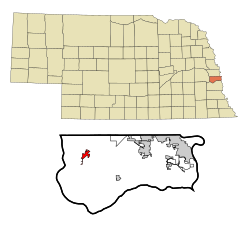Gretna, Nebraska
Gretna, Nebraska | |
|---|---|
 Location of Gretna, Nebraska | |
| Country | United States |
| State | Nebraska |
| County | Sarpy |
| Area | |
| • Total | 1.2 sq mi (3.1 km2) |
| • Land | 1.2 sq mi (3.1 km2) |
| • Water | 0.0 sq mi (0.0 km2) |
| Elevation | 1,270 ft (387 m) |
| Population (2008) | |
| • Total | 6,572 |
| • Density | 1,996.2/sq mi (770.7/km2) |
| Time zone | UTC-6 (Central (CST)) |
| • Summer (DST) | UTC-5 (CDT) |
| ZIP code | 68028 |
| Area code | 402 |
| FIPS code | 31-20260Template:GR |
| GNIS feature ID | 0829697Template:GR |
Gretna is a city in Sarpy County, Nebraska, United States. The population was 2,355 at the 2000 census. In 2008, its population was estimated to be 6,572 [1]. Gretna has the fastest rate of growth of any Nebraska city since 2000.
History
Gretna started shortly after the Burlington Railroad built a short line between Omaha and Ashland in the summer of 1886. Advent of the village of Gretna on this new laid rail line was the cue for the exit of the nearby trading post of Forest City, which had existed since 1856. In its day, Forest City, located 2.5 miles southwest of where Gretna now stands, was a flourishing and busy place, but it was doomed by the rail road which passed it by. The only marker that exists today to show the site of old Forest City is the cemetery (Holy Sepulcher) which is located a little the east of what was the center of activity in the settlement. Names that were prominent in the beginnings of Forest city were the families of William Langdon, John Thomas and John Conner.
The Lincoln Land Company, recognizing the potential of the site, surveyed and plotted the town site of Gretna in 1887. The village was incorporated by July 10, 1889. The name suggest Scotland's Gretna Green, the ancestral county of some of the earliest settlers.
Geography
Gretna is located at 41°8′20″N 96°14′42″W / 41.13889°N 96.24500°W (41.138898, -96.244947).Template:GR
According to the United States Census Bureau, the city has a total area of 1.2 square miles (3.1 km²), all of it land.
The nearest hospitals are Lakeside Hospital (9.5 miles) located in Omaha, Nebraska or Midlands Hospital in Papillion, Nebraska (11.4 miles). Papillion is also the location of the county courthouse.
Demographics
As of the censusTemplate:GR of 2000, there were 2,355 people, 889 households, and 642 families residing in the city. The population density was 1,996.2 people per square mile (770.6/km²). There were 917 housing units at an average density of 777.3/sq mi (300.0/km²). The racial makeup of the city was 98.64% White, 0.04% African American, 0.42% Native American, 0.42% Asian, 0.17% from other races, and 0.30% from two or more races. Hispanic or Latino of any race were 1.15% of the population.
There were 889 households out of which 38.1% had children under the age of 18 living with them, 58.0% were married couples living together, 11.6% had a female householder with no husband present, and 27.7% were non-families. 23.5% of all households were made up of individuals and 10.0% had someone living alone who was 65 years of age or older. The average household size was 2.59 and the average family size was 3.07.
In the city the population was spread out with 28.1% under the age of 18, 8.3% from 18 to 24, 28.6% from 25 to 44, 21.9% from 45 to 64, and 13.0% who were 65 years of age or older. The median age was 36 years. For every 100 females there were 89.9 males. For every 100 females age 18 and over, there were 86.2 males.
The median income for a household in the city was $50,112, and the median income for a family was $56,410. Males had a median income of $37,868 versus $27,569 for females. The per capita income for the city was $21,729. About 2.3% of families and 3.6% of the population were below the poverty line, including 3.4% of those under age 18 and none of those age 65 or over.
References
- ^ U.S. Census Bureau, 2008 Population Estimates, factfinder.census.gov


